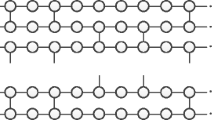Abstract
In this paper, we present a sessional blind signature protocol whose security is guaranteed by fundamental principles of quantum physics. It allows a message owner to get his message signed by an authorized signatory. However, the signatory is not capable of reading the message contents and everyone can verify authenticity of the message. For this purpose, we took advantage of a sessional signature as well as quantum entangled pairs which are generated with respect to it in our proposed protocol. We describe our proposed blind signature through an example and briefly discuss about its unconditional security. Due to the feasibility of the protocol, it can be widely employed for e-payment, e-government, e-business and etc.

Similar content being viewed by others
References
Chaum, D.: Blind signature for untraceable payments. Advances in cryptology, proceeding of CRYPTO’82, pp. 199–203. Springer, New York (1983)
Harn, L.: Cryptanalysis of the blind signature based on the discrete logarithm. Electron. Lett. 31(14), 1136–1137 (1995)
Fan, C., Lei, C.: Efficient blind signature scheme based on quadratic residues. Electron. Lett. 32(9), 811–813 (1996)
Nielsen, M., Chuang, I.: Quantum Computation and Quantum Information. Cambridge University Press, Cambridge (2000)
Bennett, C.H., DiVincenzo, D.P.: Quantum information and computation. Nature 404, 247–55 (2000)
Galindo, M.A., Delgado, M.: Information and computation: classical and quantum aspects. Rev. Mod. Phys. 74, 347–423 (2002)
Zeng, G., Ma, W., Wang, X., Zhu, H.: Signature scheme based on quantum cryptography. Acta Electron. Sinica (in Chinese) 29(8), 1098–1100 (2001)
Gottesman, D., Chuang, I.L.: Quantum digital signatures. (2001), arXiv:quant-ph/0105032v2, URL: http://arxiv.org/abs/quant-ph/0105032v2
Wen, X.J., Niu, X.M., Ji, L.P., Tian, Y.: A weak blind signature scheme based on quantum cryptography. Opt. Commun. 282, 666–669 (2009)
Naseri, M.: Comment on a weak blind signature based on quantum cryptography. Int. J. Phys. Sci. 6(21), 5051–5053 (2011)
Su, Q., Huang, Z., Wen, Q., Li, W.: Quantum blind signature based on two-state vector formalism. Opt. Commun. 283, 4408–4410 (2010)
Ribordy, G.: Practical quantum key distribution systems based on faint laser pulses. LEOS summer topical meetings, pp. 28–29 (2006)
Elliott, C., Pearson, D., Troxel, G.: Quantum cryptography in practice. In: SIGCOMM’03: Proceedings of the Conference on Apps., Tech., Arch., and Protocols for Comp. Commun., pp. 227–238, ACM Press, New York (2003)
McMahon, D.: Quantum Computing Explained. Wiley, New Jersey (2008)
Gisin, N., Ribordy, G., Tittel, W., Zbinden, H.: Quantum cryptography. Rev. Mod. Phys. 74, 145–195 (2002)
Grzywak, A., Kowalczyk, G.P.: Quantum cryptography. Theor. Appl. Inform. 21(3–4), 149–166 (2009)
Wootters, W.K., Zurek, W.H.: A single quantum cannot be cloned. Nature 299, 802–803 (1982)
Teja, V., Banerjee, P., Sharma, N.N., Mittal, R.K.: Quantum cryptography: state-of-art, challenges and future perspectives, pp. 1296–1301. IEEE Int. Conf. on Nanotechnology (2007)
Cai, Q.Y.: Eavesdropping on the two-way quantum communication protocols with invisible photons. Phys. Lett. A 351(1–2), pp. 2325 (2006)
Deng, F.G., Zhou, P., Li, X.H., Li, C.Y., Zhou, H.Y.: Robustness of two-way quantum communication protocols against trojan horse attack. Quant. Phy. (2005) arXiv:quant-ph/0508168v1
Li, X.H., Deng, F.G., Zhou, H.Y.: Improving the security of secure direct communication based on the secret transmitting order of particles. Phys. Rev. A 74(5), 054302 (2006)
Author information
Authors and Affiliations
Corresponding author
Rights and permissions
About this article
Cite this article
Khodambashi, S., Zakerolhosseini, A. A sessional blind signature based on quantum cryptography. Quantum Inf Process 13, 121–130 (2014). https://doi.org/10.1007/s11128-013-0529-5
Received:
Accepted:
Published:
Issue Date:
DOI: https://doi.org/10.1007/s11128-013-0529-5




